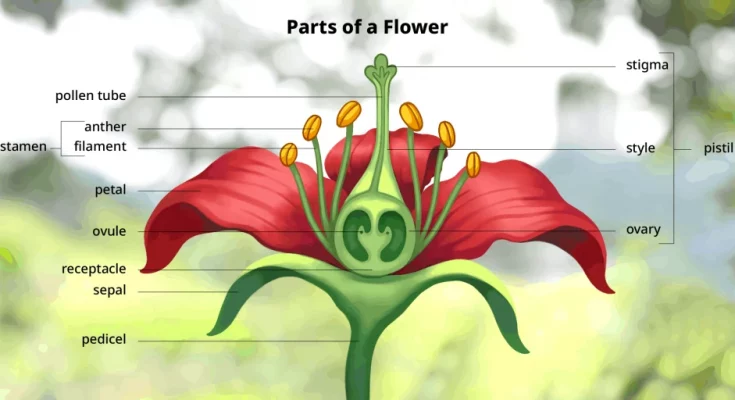Introduction
A flower is often the most visually striking part of a plant, characterised by its vibrant colours and varying shapes. But beyond its aesthetic appeal, it plays a pivotal role in the biology of angiosperms or flowering plants.
Table of Contents
Definition of a Flower-
At its core, a flower is the reproductive structure of flowering plants, also known as angiosperms. Comprising both male and female reproductive organs, it facilitates the process of fertilisation and, subsequently, the formation of seeds and fruits. Flowers can be intricate in their design, with specialised parts that cater to a specific function, be it attracting pollinators, protecting the reproductive organs, or assisting in the reproductive process itself.
Importance in Plant Reproduction
Flowers are of paramount importance in the life cycle of flowering plants. They serve as the primary means through which these plants reproduce. Through a carefully orchestrated process involving pollination and fertilisation, flowers ensure the continuation of plant species. Furthermore, by attracting a diverse range of pollinators, from bees and butterflies to birds and even bats, flowers indirectly support biodiversity and the health of ecosystems. Their role is not just limited to reproduction, but extends to the production of fruits, which provide essential nutrition to a myriad of organisms, including humans.
Also Check – FAQs on Flower- Parts, Structure ,Anatomy, Reproduction , Pollination, Fertilisation, Function
Classification of Flowers Based on Presence of Parts
Flowers are more than just a visual delight; they are sophisticated structures intricately designed for reproduction. One of the ways botanists classify them is based on the presence or absence of their main parts, leading to the categories of ‘Complete’ and ‘Incomplete’ flowers.
Complete Flowers
When you look at a flower and see it equipped with all the essential parts, you’re likely observing a complete flower. A complete flower is defined by the presence of all four primary floral whorls-
- Calyx (Sepals)- The outermost protective layer, usually green, that envelopes the bud before it blooms.
- Corolla (Petals)- The typically colourful part of the flower, which attracts pollinators.
- Androecium (Stamens)- This is the male reproductive part. It comprises the filament (stalk) and the anther, which produces pollen grains.
- Gynoecium (Carpels/Pistil)- The female reproductive organ of the flower. It consists of the ovary, which houses the ovules, the style, and the stigma, which receives the pollen during pollination.
A complete flower is like a well-oiled machine, having every part it needs to facilitate the process of pollination and reproduction.
Also Check – 7 Key Differences Between Carpel and Pistil Explained
Incomplete Flowers
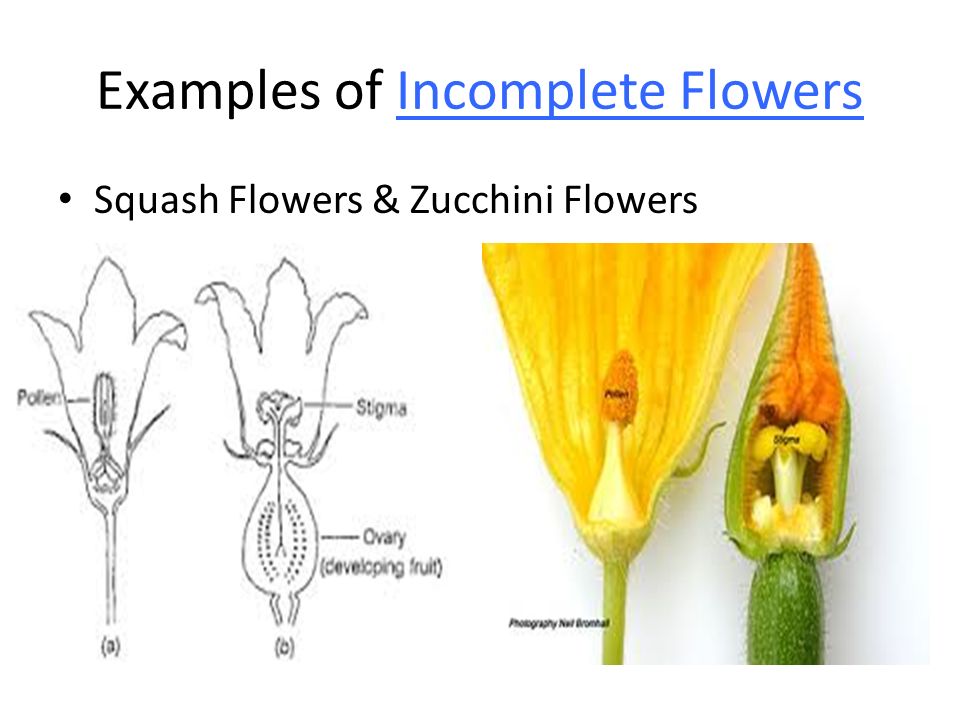
Contrary to complete flowers, incomplete flowers miss out on one or more of these primary floral whorls. It means they might lack petals, sepals, stamens, or carpels. This absence doesn’t necessarily render them sterile or non-functional; instead, it often signifies a different strategy of reproduction. For example-
- A flower lacking petals might rely more on wind for pollination than attracting pollinators.
- If a flower lacks stamens, it’s strictly female and requires pollen from a different flower to reproduce.
Parts of a Flower
Every flower, whether it’s the vibrant rose in your backyard or the subtle daisy you see in the park, is a symphony of parts working together. While flowers vary in design and function, their parts are generally consistent. Among these, the vegetative parts play essential roles in protection and attraction.
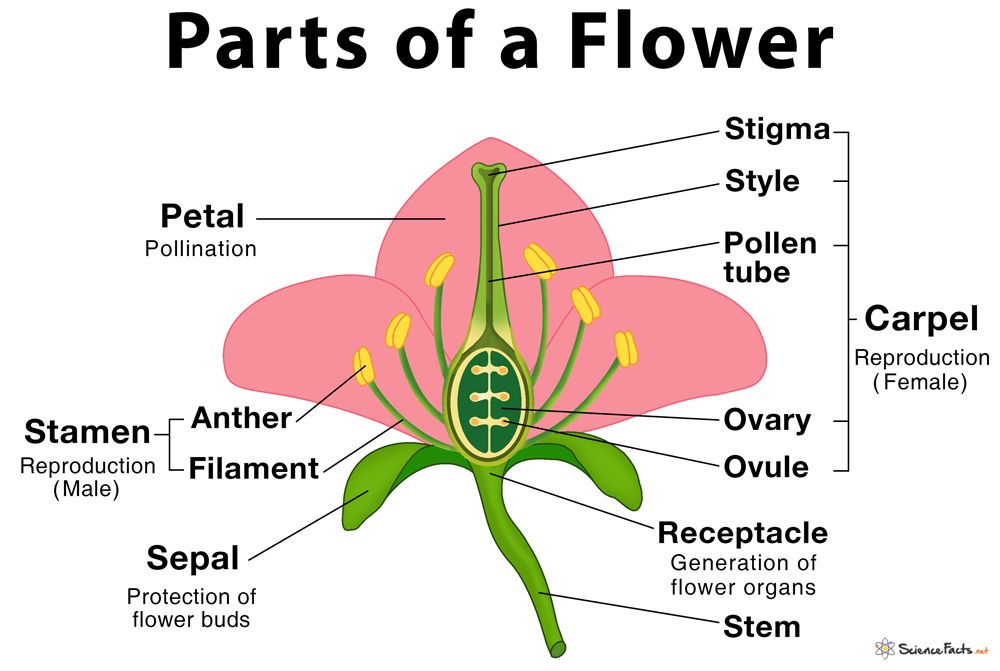
Vegetative Parts of a Flower-
Petals (Corolla)
- Definition- Petals are the colourful, often fragrant parts of the flower. Collectively, they form what we term as the corolla. Their aesthetic allure is what we typically recognize as the ‘flower’.
- Function- The primary function of petals is to attract pollinators. Be it the vibrant hues or the intoxicating fragrance, petals are nature’s billboard advertising the nectar or pollen present inside. Their designs are often tailored to the preferences of specific pollinators, ensuring effective pollination.
- Different Forms of Corolla- Petals are not a one-size-fits-all structure. Depending on the flower’s evolutionary history and its primary pollinators, petals take on varied shapes. Some of the distinct forms include-
- Tubular- Resembling a tube, these are often seen in flowers pollinated by long-tongued insects or birds, like hummingbirds. Examples include trumpet vines and some lilies.
- Bell-shaped- These flowers, as the name suggests, take the shape of a bell. Bluebells and campanula are classic examples.
- Funnel-shaped- With a wide opening that narrows down, funnel-shaped flowers are akin to a funnel. Morning glory and some species of datura exhibit this form.
Sepals (Calyx)
- Definition- Sepals are the outermost parts of a flower, usually green, although in some plants they can be colorful and petal-like. When you observe a flower bud, the parts encasing it are the sepals. Together, they form the calyx.
- Function- Sepals are the flower’s first line of defence. Their primary role is to shield the delicate inner parts of the flower, especially when it’s still a bud. They protect the flower against potential harm from external factors, be it harsh weather, pests, or physical damage.
Also Check – Angiosperms- Characteristics, Classification, and Reproductive Biology
Reproductive Parts of a Flower
Every flower serves a purpose beyond mere aesthetics- reproduction. The true marvel of a flower lies in its reproductive components, which are vital for the continuation of plant species. Among these, the stamen stands out as the male reproductive part.
Stamens (Male)-
Anatomy-
- Filament- When you look closely at a flower, you’ll often observe slender, thread-like structures emerging from its base. These are the filaments, acting as the supporting stalks for the anther. Filaments are usually long and thin, ensuring that the anther is positioned favourably for effective pollen transfer.
- Anther- Positioned at the tip of the filament, the anther is a critical part of the flower. It’s typically a bi-lobed structure and might appear as a tiny sac or capsule. This is where the magic happens – the production of pollen grains, which are the male gametes in plants.
Production of Pollen-
- Pollen Genesis- Inside the anther, there are specialised cells that undergo a process known as meiosis. This process produces pollen grains, each containing half the genetic information. These grains are essential for fertilisation as they will eventually merge with female gametes.
- Pollen Features- Pollen grains, although microscopic, have distinct features. They come in various shapes, sizes, and even colours. A pollen grain’s outer layer, called the exine, is often sculptured and patterned, characteristics that are used in plant taxonomy and forensic studies.
- Pollen Release- Once mature, the anther’s structure facilitates the release of these pollen grains. Depending on the flower’s design and its primary pollination mechanism (wind, insect, bird, etc.), the anther will release pollen in a manner most conducive to reaching a flower’s female counterpart, the pistil.
Also Check – Sexual Reproduction in Flowering Plants
Carpels/Pistil (Female)-
At the heart of a flower’s reproductive lies its female part- the carpel or pistil. It’s an intricate structure, uniquely designed to produce, protect, and facilitate the union of gametes, ensuring the continuation of plant species.
Anatomy-
- Ovary- Situated at the base of the pistil, the ovary is a crucial component. Within its confines, the ovary shelters the ovules, which are the female gametes or potential seeds. Post-fertilization, the ovary undergoes a transformation, maturing into the fruit which we commonly consume.
- Style- Rising from the ovary is the style, a slender and elongated structure. It serves as a conduit, guiding the pollen grains (which land on the stigma) down to the ovules housed in the ovary.
- Stigma- The terminal part of the pistil, the stigma, is sticky or feathery in nature. This characteristic allows it to efficiently trap or catch pollen grains. Depending on the species, the stigma might be flat, globular, or even feather-like, always adapted for optimal pollen reception.
Production and Protection of Ovules-
- Ovule Genesis- Within the ovary, specialised cells undergo a developmental process to become ovules. Each ovule houses an egg cell, which is the female gamete ready for fertilisation.
- Protection- The ovary provides a natural protective layer for the ovules. This barrier ensures that the ovules remain shielded from pathogens, pests, and environmental stresses. The ovary’s protective nature is also evolutionary, ensuring that only the right pollen (often from the same species) fertilises the ovule.
- Fertilisation and Seed Formation- Once a pollen grain reaches the stigma, it grows a tube through the style to reach the ovule. Upon successful penetration, the male gamete from the pollen grain merges with the egg cell in the ovule, resulting in fertilisation. The fertilised ovule then begins its transformation into a seed, while the surrounding ovary starts its journey to become a fruit.
Whorls of a Flower
When observing a flower, its intricate organisation isn’t merely by chance; every structure is systematically arranged in circles or rings termed as ‘whorls’. Understanding these whorls is key to unravelling the functional and aesthetic marvel that is a flower.
Definition of a Whorl-
A whorl refers to a set or circle of similar parts (like petals or sepals) of a flower that are arranged around the same central point, usually the receptacle. Each whorl consists of similar floral organs, and a typical flower contains several whorls, each playing a distinct role in the flower’s biology.
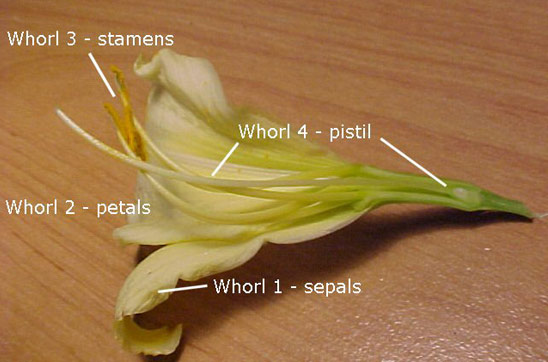
Calyx (Sepals)- The Outermost Whorl
- Definition- The calyx is the outermost whorl of a flower. When observing a flower, especially in its bud stage, you’ll notice protective leaf-like structures. These are the sepals, and together they form the calyx.
- Function- The primary role of the calyx is protection. In the bud stage, sepals encase and safeguard the inner, more delicate parts of the flower from potential harm, be it environmental factors or pests. Additionally, they play a minor role in photosynthesis due to their green coloration.
- Variability- While typically green, in some flowers, sepals can be as vibrant and petal-like as the corolla, leading to what’s termed a petaloid calyx, seen in flowers like the lily.
Corolla- The Second Whorl
- Definition- Just inside the circle of sepals lies the corolla, which is undeniably the most visually striking whorl in most flowers. This whorl consists of the petals, which often flaunt vibrant colours and emit fragrances.
- Function- The corolla primarily functions as a pollinator magnet. Through a combination of colour, scent, and nectar guides, petals attract various pollinators, facilitating the process of pollination. Their design can be adapted to specific pollinators, from bees and butterflies to hummingbirds.
- Variability- Petals come in a plethora of shapes, sizes, and patterns. From the simple, white daisy to the complex, orchid; from the tubular honeysuckle to the wide-open sunflower – the diversity of corolla forms is a testament to nature’s creativity.
Androecium (Stamen)- The Third Whorl
The androecium is an integral part of a flower’s reproductive system, focusing on the male aspect of reproduction.
- Definition- The term “androecium” derives from the Greek words for “man” and “house”. This whorl is composed of multiple units called stamens, each of which represents the male reproductive organ of the flower.
- Anatomy of Stamens- A stamen typically consists of-
- Filament- This is a slender, thread-like structure that supports the anther, elevating it for effective pollen distribution.
- Anther- Positioned atop the filament, the anther is a sac-like structure responsible for producing pollen grains, the male gametes.
- Function- The androecium plays a pivotal role in plant reproduction. The anthers produce pollen grains that, upon maturation, are ready to be transferred to a flower’s stigma, initiating the process of fertilisation.
- Variability- The configuration and number of stamens can vary widely among different plant species. While some flowers might boast just a single stamen, others can have numerous, often arranged in intricate patterns or fused formations.
Gynoecium (Carpel/Pistil)– The Innermost Whorl
Nestled deep within the flower, the gynoecium represents the essence of the flower’s female reproductive system.
- Definition- The term “gynoecium” hails from Greek words for “woman” and “house”. It encompasses one or more units termed carpels or pistils, each representing the female reproductive organ of the flower.
- Anatomy of a Carpel/Pistil- A typical carpel consists of-
- Ovary- Located at the base, the ovary encloses ovules, which upon fertilisation develop into seeds.
- Style- A columnar structure extending from the ovary, the style acts as a channel for pollen tubes to grow and reach the ovules.
- Stigma- Situated at the style’s tip, the stigma is often sticky or specialised to capture and recognize the appropriate pollen grains.
- Function- The gynoecium is vital for plant reproduction. The ovules housed in the ovary await the arrival of pollen grains. Once a pollen grain lands on the stigma, it grows a tube through the style, aiming to fertilise an ovule.
- Variability- Depending on the species, flowers can have a single carpel or multiple carpels. These can be free-standing or fused together. The shape, size, and configuration of the gynoecium can vary widely, influenced by evolutionary adaptations to optimise fertilisation.
Pollination- Nature’s Way of Continuing Life
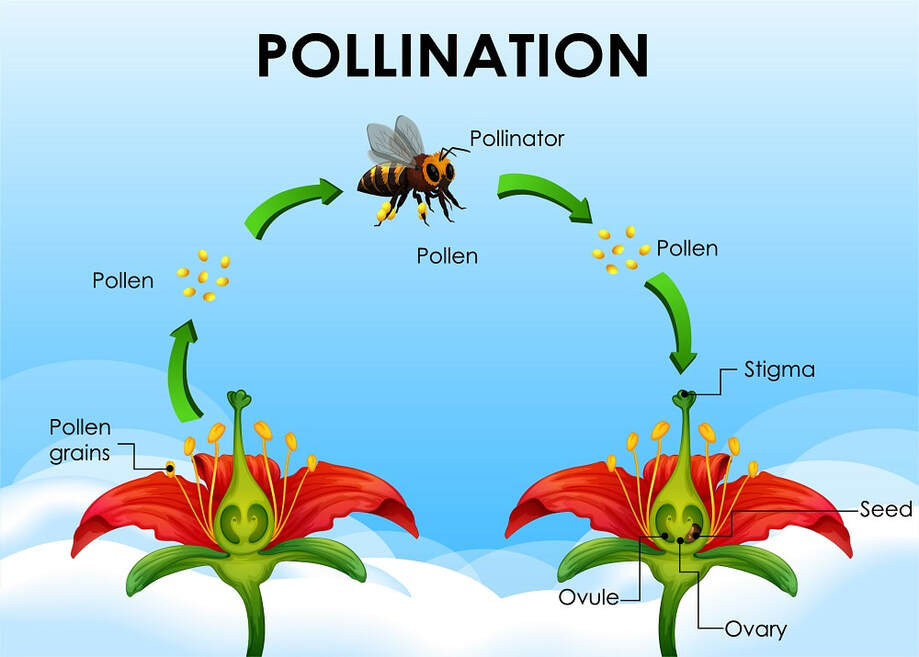
Pollination is the silent dance of nature that ensures the continuation of many plant species. It’s a process that has fascinated botanists for centuries and plays a crucial role in the biodiversity of our planet.
Definition of Pollination-
Pollination refers to the act of transferring pollen grains from a flower’s male reproductive structure (anther) to the female reproductive part (stigma) of the same or another flower. This transfer is a prelude to fertilisation, the union of male and female gametes leading to the production of seeds.
Transfer of Pollen from Anther to Stigma-
The journey of pollen is one filled with challenges. From its genesis in the anther, the pollen grain must find its way to a compatible stigma. This transfer can happen through various agents, including wind, water, birds, insects, and even animals. The goal? To reach a receptive stigma, germinate, and fertilise an ovule.
Pollination Process-
- Initiation- The process starts with the maturation of pollen grains in the anther. Once mature, the anther bursts open, releasing the pollen.
- Transfer- Depending on the flower species and its evolutionary adaptations, pollen is transferred via different mediums. For instance, a brightly colored, fragrant flower might attract bees, while long, tubular flowers might be more suited for hummingbirds.
- Reception- A successful pollination culminates when the transferred pollen lands on a compatible stigma, beginning its microscopic journey down to the ovule.
Self-pollination vs. Cross-pollination-
- Self-pollination- This is a process where a flower pollinates itself. Pollen from an anther of a flower is transferred to the stigma of the same flower or another flower on the same plant. While this method ensures seed production, it reduces genetic diversity. Plants like peas and wheat often exhibit self-pollination.
- Cross-pollination- Far more common in nature, cross-pollination involves the transfer of pollen from the anther of one flower to the stigma of a different flower on another plant of the same species. This method promotes genetic diversity, which can be advantageous for adaptability and survival. Flowers such as roses, apples, and cherries typically rely on cross-pollination.
Also Check – 16 Important Differences between Cross Pollination and Self Pollination
Pollination Medium- Navigating Nature’s Pathways
Pollination doesn’t happen in isolation. Nature has designed multiple avenues through which pollen grains travel, ensuring a higher chance of successful fertilisation. Each of these mediums serves a unique purpose and caters to specific plant species.
Wind (Anemophily)-
- Description- Many plants, especially those that produce lightweight pollen, rely on wind for pollination. These plants typically have flowers that are inconspicuous, lacking scent and nectar.
- Examples- Grasses, conifers, and many deciduous trees like oaks and maples.
Water (Hydrophily)-
- Description- This is less common than wind or animal pollination. Plants residing in aquatic environments may use water as a medium. They usually release pollen grains that float on water surfaces or are submerged.
- Examples- Seagrasses and some species of pondweeds.
Animals-
- Insects (Entomophily)- Flowers adapted to insect pollination are often brightly colored with appealing scents. They provide rewards like nectar.
- Examples- Roses, sunflowers, and orchids.
- Birds (Ornithophily)- Flowers suited for bird pollination are usually brightly colored, often red or yellow, with tubular shapes containing rich nectar.
- Examples- Trumpet vine, hummingbird sage, and some species of eucalyptus.
- Bats (Chiropterophily)- Bats often pollinate flowers that open at night. These flowers are typically large, pale or white, and emit strong, sweet odors.
- Examples- Agave, banana, and the sausage tree.
Importance of Pollination- Planting Seeds for the Future
Pollination is more than just a botanical process. It’s nature’s way of ensuring continuity, variety, and abundance.
Ensuring Genetic Diversity-
Through cross-pollination, plants can exchange genetic material, leading to offspring with varied genetic codes. This genetic diversity is crucial as it enhances the adaptability and resilience of plant populations, helping them thrive in changing environments.
Seed and Fruit Formation-
Pollination paves the way for fertilisation, where male and female gametes unite. Once fertilised, the ovule transforms into a seed, and the surrounding ovary often develops into a fruit. These seeds ensure the continuation of plant species, while fruits, consumed by animals, help in seed dispersal. Additionally, many fruits form a vital part of human and animal diets, underscoring the broader ecological significance of pollination.
Also Check – “Pollination is Prerequisite for Fertilization in Flowering Plants” Explain
Fertilisation- Nature’s Alchemy in Seed Creation
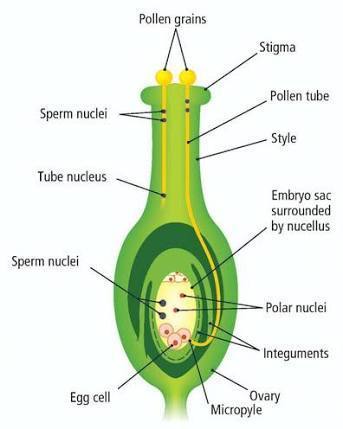
Fertilisation, a marvel of plant biology, signifies a defining moment in the life cycle of flowering plants. It’s when individual pollen grains, after their adventurous journey, fulfil their ultimate destiny- combining with an ovule to form the genesis of a new plant.
Also Check – 12 Important Difference Between Pollination and Fertilisation
The Dance of Gametes-
- Pollen’s Journey- Upon landing on a compatible flower’s stigma, a pollen grain starts to germinate, creating a pollen tube. This tube, acting like a conduit, grows down the style, navigating towards the ovary.
- Fusion- Once the pollen tube reaches the ovary, it releases the male gametes. One of these gametes will fuse with the female gamete or egg cell housed within the ovule. This union is the essence of fertilisation.
From Single Cells to Seeds-
- Zygote Formation- The moment the male and female gametes merge, they form a zygote. This single cell is the potential beginning of a new plant and contains genetic information from both parent plants.
- Transformation into Seed- Post-fertilization, the zygote starts to divide and differentiate, gradually developing into an embryo. Meanwhile, the surrounding tissues of the ovule mature into a protective covering known as the seed coat. The entirety, with its nascent embryo and protective coat, is recognized as a seed.
Significance of Seeds-
- Continuity of Species- Seeds carry the legacy of their parent plants, ensuring the survival and proliferation of their species.
- Dormancy and Adaptation- Many seeds possess the ability to remain dormant under unfavourable conditions, sprouting only when the environment is conducive. This adaptability is key to the survival of many plant species across varied ecosystems.
Flower Functions- The Multifaceted Role of Nature’s Bloom
Flowers, beyond their undeniable aesthetic appeal, play vital roles in the ecosystem and the life cycle of plants. They are not merely ornaments of the botanical world; they are powerhouses driving the continuation and evolution of plant species.
Reproduction-
- Sexual Reproduction- The primary function of most flowers is sexual reproduction. They produce male (pollen) and female (ovules) gametes, facilitating the fusion of these gametes through the process of fertilisation.
- Seed Production- Post-fertilization, flowers facilitate the transformation of fertilised ovules into seeds, ensuring the propagation of their species.
Attraction-
- Pollinators’ Beacon- Flowers utilise a combination of colours, shapes, patterns, and scents to attract specific pollinators like bees, butterflies, birds, or bats. This attraction is mutually beneficial- while pollinators aid in the transfer of pollen, they often receive nectar or pollen as food in return.
- Mimicry- Some flowers have evolved to mimic other organisms or objects to lure pollinators. For instance, the bee orchid’s appearance resembles a female bee, enticing male bees to “mate” with it, thereby aiding in its pollination.
Protection-
- Defensive Structures- Some flowers have thorns or produce substances that deter herbivores or protect against microbial infections.
- Encapsulation- By enclosing their reproductive parts, flowers protect them from potential damage or desiccation.
Regulation of Genetic Diversity-
- Cross-Pollination- Flowers promote genetic diversity by favouring cross-pollination, ensuring the mixing of genetic material from different individual plants.
- Gene Flow- Flowers facilitate gene flow, which is the transfer of genetic variations from one population to another, maintaining healthy genetic diversity within species.
Food Source-
- Nectar and Pollen- Flowers provide nectar and pollen, essential food sources for a myriad of pollinators, including bees, hummingbirds, and butterflies.
- Edible Flowers- Some flowers, like hibiscus or squash blossoms, are directly consumed by humans and are cherished in various cuisines around the world.
Symbiotic Relationships-
- Mutual Benefits- Flowers engage in symbiotic relationships with certain animals. For instance, ants protect peony buds from herbivores, and in return, the peony provides nectar for the ants.
- Seed Dispersal- Some flowers produce fruits that are consumed by animals. These animals, in turn, disperse the seeds contained within the fruits, aiding in the plant’s reproduction.
References-
- Raven, P. H., Evert, R. F., & Eichhorn, S. E. (2013). Biology of Plants. W. H. Freeman and Company.
- Taiz, L., Zeiger, E., Møller, I. M., & Murphy, A. (2015). Plant Physiology and Development. Sinauer Associates.
- Proctor, M., Yeo, P., & Lack, A. (1996). The Natural History of Pollination. Timber Press, Portland, Oregon.
- Willmer, P. (2011). Pollination and Floral Ecology. Princeton University Press.
- Seymour, R. S., & Schultze-Motel, P. (1997). Physiology of flower and fruit development. Encyclopaedia of Applied Plant Sciences.
- Kew Science – Plants of the World Online
- Encyclopedia Britannica – Flower
